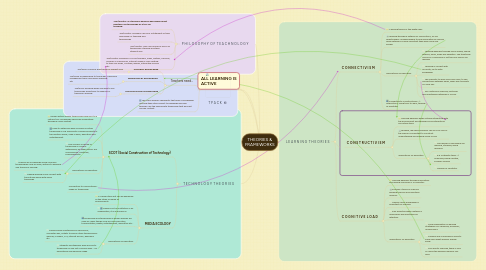
1. ALL LEARNING IS ACTIVE
2. T E C H N O L O G Y T H E O R I E S
2.1. SCOT (Social Construction of Technology)
2.1.1. Human action shapes technology because it is a cultural tool. Technology should be understood through a social context.
2.1.2. Used to determine how successful certain technology is e.g. popularity of Apple products in the Western world, used in work, education and entertainment
2.1.3. The success or failure of technology is socially determined, by other factors e.g. economically, politically, psychologically
2.1.4. Implications on Education
2.1.4.1. Schools are increasingly using common technologies such as iPads, laptops to enhance and transform learning.
2.1.4.2. Making learning more 'current' with the outside world with using technolgy
2.1.5. Connection to Connectivism: usage of technology
2.2. MEDIA ECOLOGY
2.2.1. Is a broad term but can be explained as the study of media as environments
2.2.2. Media is not an institution or an organization, it is all around us
2.2.3. Technology and techniques in human affaires are used for many things such as communication, transportation, health, entertainment, education etc...
2.2.4. Implications on Education
2.2.4.1. Schools have smartboards in classrooms, computer labs, outlets to plug in other technological devices, iClickers, TVs, internet access, webcams etc
2.2.4.2. Students and teachers have access to technology in and out of school daily - for educational and personal usage
3. T P A C K
3.1. Teachers need...
3.1.1. CONTENT KNOWLEDGE
3.1.1.1. Having a great grasp of subject area
3.1.2. PEDAGOGICAL KNOWLEDGE
3.1.2.1. Knowing how to teach well, classroom management skills and lesson planning etc
3.1.3. TECHNOLOGICAL KNOWLEDGE
3.1.3.1. Knowing when and how to use technology effectively to enhance or transform learning.
3.2. The Venn diagram represents the types of knowledge and how they interconnect to pedagogically help teachers use the appropriate technology that will best convey content.
4. P H I L O S O P H Y O F T E A C H N O L O G Y
4.1. Is a teacher’s personal philosophy about how they use technology as a tool for teaching.
4.2. Teachers can form a statement of their philosophy of teaching and teachnology
4.3. This can include all forms of technology a teacher and their students use
4.4. Examples: PLN for teachers, iPads, laptops, cameras, iClickers in classrooms, internet usage in class relating to topic eg. blogs, YouTube, games, interactive lessons etc
5. L E A R N I N G T H E O R I E S
5.1. C O N N E C T I V I S M
5.1.1. “Learning theory of the digital age”
5.1.2. Learning through a network of connections, for full effectiveness: knowing where to find information by having good networks is more important than how much one knows!
5.1.3. Implications on Education
5.1.3.1. Learning happens through social media, search engines, email, blogs and websites. The traditional course in a classroom is not the only source for learning
5.1.3.2. Learning is current with accurate, up-to-date knowledge
5.1.3.3. The capacity to learn more and more, to see connections between fields, ideas and concepts is a core skill
5.1.3.4. For continuous learning, nurturing and maintaining networks is crucial.
5.1.4. Connected to Constructivism → interactions, using tools to learn, teacher as facilitator
5.2. C O N S T R U C T I V I S M
5.2.1. Learning happens when actively interacting with the environment and through social interactions ad cultural tools
5.2.2. Tangible, real world learning. The ACTIVE role of the learner is important to construct understanding and making sense of info
5.2.3. Implications on Education
5.2.3.1. The learner is responsible for learning, studying, doing research
5.2.3.2. E.g. Authentic tasks → analyzing, being creative, problem solving
5.2.3.3. Teacher as facilitator
5.3. C O G N I T I V E L O A D
5.3.1. Learning happens through information processing."The brain is a computer"
5.3.2. Involves 2 types of memory working memory and long term memory
5.3.3. Having a prior knowledge is important for learning
5.3.4. Fully effective when material is meaningful and practicing for retention
5.3.5. Implications on Education
5.3.5.1. More organization in learning strategies e.g. Chunking, acronyms, mneumonics
5.3.5.2. Schema and scaffolding is used to build upon what learners already know
5.3.5.3. Can lead to overload, there is only so much the working memory can hold
